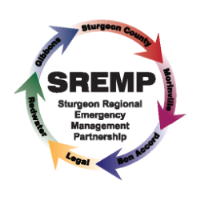Emergency Preparedness
Emergencies can happen at any time, anywhere and your best defence is to be prepared. Do you know what to do to keep you and your family safe?
72 Hours: Is Your Family Prepared?
If an emergency happens, it may take emergency workers some time to reach you. You should be prepared to take care of yourself and your family for at least 72 hours.
The Department of Public Safety and Emergency Preparedness will help you learn what to do in the event of an emergency. You can also learn how to make a plan with the Are You Prepared? pamphlet.
- Hazard preparedness
- Build an emergency kit
- Pet preparedness
- Farm animals and livestock
- Raise awareness in our community
- Make an emergency plan
- Emergency preparedness
Basic emergency kit
A basic emergency kit should contain:
- Water - min 2 litres of water per person per day; include small bottles that can be carried easily in case of an evacuation order
- Canned food, energy bars and dried foods (replace food and water once a year)
- Manual can-opener
- Crank or battery-powered radio (and extra batteries) or Weatherradio
- First aid kit
- Extra keys to your car and house
- Some cash in smaller bills, such as $10 bills
- A copy of your emergency plan and contact information
- Other items such as prescription medication, infant formula, and equipment for people with disabilities
Information sources
If there is an emergency in our community, you can use these sources for information and updates:
- Alberta Emergency Alert Twitter: @AB_EmergAlert
- Northeast Region Community Awareness Emergency Response Update Line 1-866-653-9959
- Sturgeon Regional Emergency Management Partnership
- Town of Morinville Facebook
- Town of Morinville Twitter
- Town of Morinville Office at 780-939-4361
- Alberta Emergency Management Agency
9-1-1 Calls
The staff at 9-1-1 need specific information to help you during an emergency. Be prepared to provide:
- Your location
- Your name
- What help you need
- What happened
Please do not hang up the phone in case their staff need more information.
Emergency contact numbers
Should you have a service provider emergency, please call your provider directly.
Below is a list of the most common providers (however; may not be inclusive of all those offering services in the area):
- Public Works (Water and Sewer): 780-939-2590 (8 a.m. to 4 p.m.; 780-965-0994 (after-hours)
- Epcor (Electricity): 780-412-4500 (24 hour emergencies)
- Fortis Alberta (Electricity): 780-310-9473 (780-310-WIRE)
- Atco Gas (Natural Gas): 780-420-5585 (24 hour emergencies)
- Alta Gas (Natural Gas): 1-866-222-2068 (24 hour emergencies)
- Telus (Telephone/Internet): 780-310-3131
- Shaw (Telephone/Internet): 1-888-344-7429
Regional collaborations
Sturgeon Regional Emergency Management Partnership (SREMP)
The municipalities of Morinville, Sturgeon County, Gibbons, Redwater, Bon Accord, and Legal created and adopted a singular bylaw. This bylaw details a funding formula and an Emergency Response Plan. This helps each municipality with emergency training and response.
Northeast Region Community Awareness Emergency Response (NR CAER)
Northeast Region CAER is a mutual aid emergency response group formed in 1991. Members include emergency management professionals and the emergency response departments of Fort Saskatchewan, Bruderheim, Gibbons, Lamont, Morinville, Redwater and the counties of Lamont, Strathcona and Sturgeon. Together, we train, plan and share best practices for emergency response in our area.
Contact Us
Town of Morinville
10125 100 Ave.
Morinville, AB T8R 1L6
Phone: 780-939-4361
Subscribe
Stay up to date on the Town's activities, events, programs and operations by subscribing to our news.









